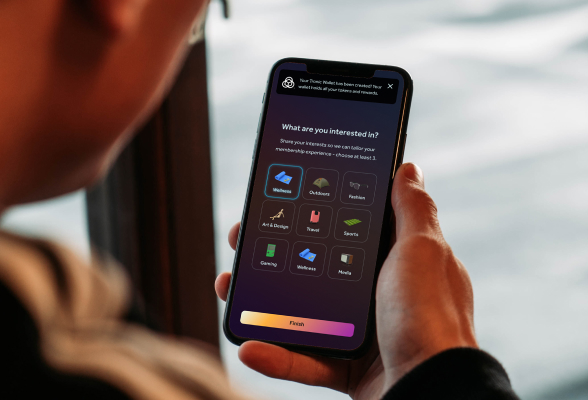From Data to Devotion:
The Path to Customer-Centric Loyalty Success

Creating loyalty programs that truly put customers first is becoming the secret sauce for businesses looking to shine in today's ever-changing market. It's more than just tallying up points for purchases; it's about building real, lasting connections with each and every customer. But here's the tricky part: how do we walk this path the right way, making sure we keep things personal without stepping on toes when it comes to privacy? Let's explore what it truly means to be customer-centric, the foundational pillars of customer-centric loyalty programs, and how to effectively design these programs.
Understanding Customer-Centricity
In a nutshell, customer-centricity is learning to see your business through your customers' eyes. It sounds straightforward, right? But it's a bit like solving a puzzle with pieces that are constantly changing shape. It's not just about knowing what your customers want today, but also guessing what they'll crave tomorrow, next month, or even next year.
This journey starts with really listening to your customers, diving deep into their world, and understanding the whys behind their choices. It's about picking up on their needs, preferences, and even those little quirks that make them unique. But how do you gather all this gold without stepping over the line into their private space or bombarding them with so many questions that they start avoiding you?
There's also the big shift in culture to consider. Moving from a product-centered mindset, where the product reigns supreme, to a customer-centered one, where the customer wears the crown, isn't just a small step; it's a giant leap. It means rethinking how decisions are made, ensuring that every choice, big or small, considers the customer's perspective. It's about creating a culture where everyone from the top down is tuned into what makes the customers tick, committed to not just meeting but exceeding their expectations.
Customer-centricity is about weaving your customers into the very fabric of your business, ensuring that every product developed, every service, every offer and interaction feels personal and valuable to them.
The Pillars of Customer-Centric Loyalty Programs
Think of Personalization, Value Proposition, Interaction, and Adaptability as the building blocks of a loyalty program that really speaks to your customers. These aren't just buzzwords; they're what make your customers feel seen and appreciated, turning every purchase into an opportunity for a deeper connection. By zeroing in on these essentials, businesses can create loyalty programs that don't just tick boxes but win hearts, keeping customers coming back for more.
1. Personalization: Beyond just a name on an email, personalization means tailoring experiences to individual preferences. The difficulty isn’t just in collecting data but in leveraging this information to create genuinely personalized experiences that resonate with each customer. This often requires sophisticated data analysis tools and creative thinking to ensure rewards and communications are tailored and relevant.
2. Value Proposition: It's vital that the benefits of a loyalty program clearly outweigh the costs, not just in terms of money but also in the effort and time invested by the customer.
3. Engagement and Interaction: Creating multiple touchpoints, to be where they are, for engagement is crucial. The challenge is to integrate these touchpoints seamlessly across various channels and to use technology to enhance, not hinder, the customer experience.
4. Flexibility and Adaptability: Customer needs and market trends are always evolving. A customer-centric loyalty program must be flexible enough to adapt to these changes. This means being willing to iterate and evolve your program based on customer feedback and market research.

Designing Your Customer-Centric Loyalty Program
Not all customers are cut from the same cloth. Recognizing this is step one. The real magic happens when you can group your customers in a way that makes sense, allowing you to personalize your loyalty program just for them. It's a bit like being a tailor for your customers' needs and preferences, ensuring every reward feels like it's made-to-measure.
Then, you've got to know what you're shooting for. Without a clear target, you're just shooting arrows in the dark. Setting solid goals and knowing exactly how you'll measure them—especially how happy and satisfied your customers are—turns that darkness into daylight.
Listening is everything. Your customers have a lot to say, and what they share can turn your loyalty program from good to great. But it's not just about collecting feedback; it's about showing your customers that their voice can lead to real changes. It's like having an ongoing conversation where both sides are truly heard.
And let's not forget the tech. Today's world moves fast, and staying ahead means embracing the latest technology that can make your loyalty program stand out. It's about finding those tech solutions that fit just right with what you're trying to achieve and what your customers will love.
So, as you dive into designing your customer-centric loyalty program, remember: it's about understanding, aiming, listening, and innovating.
The Privacy Puzzle: Collecting Customer Data Without Crossing the Line
We've laid the groundwork for creating a loyalty program that truly resonates with your customers, focusing on personalization, clear goals, active listening, and the smart use of technology. But here's the million-dollar question: How do you gather all the insights you need about your customers to make this happen, without stepping over the line into privacy issues? As we transition to the next section, we'll dive into the art and science of collecting customer data ethically and legally. It's all about striking the perfect balance between getting to know your customers intimately and respecting their privacy boundaries.
Transparent Communication: The first step is always clear communication. Let your customers know what data you're collecting and exactly how it will be used. This transparency builds trust and ensures compliance with privacy laws and regulations.
Blockchain Technology: Blockchain offers a secure, transparent way to store customer data. Its decentralized nature means that data isn't just secure; it's also less susceptible to breaches, providing peace of mind for both businesses and customers.
*With blockchain, each transaction or data exchange is recorded in a block and added to a chain in a manner that is both transparent and unchangeable. This means once data is recorded, it cannot be altered or deleted, which adds a layer of security and trust. Customers can have more control over their data, choosing what to share and with whom, through the use of smart contracts. These are self-executing contracts with the terms of the agreement directly written into lines of code.
*Blockchain's decentralized nature means that there is no central point of failure, reducing the risk of data breaches. This technology also allows for anonymous verification, where businesses can verify the authenticity of the customer's data without needing to access the data itself, further protecting customer privacy.
*By leveraging blockchain, businesses not only adhere to privacy laws and regulations more effectively but also build stronger trust with their customers by showing a commitment to protecting their data. This trust is crucial in developing long-term, customer-centric relationships that are the foundation of successful loyalty programs.
Opt-In and Consent Mechanisms: Implementing clear opt-in procedures for data collection emphasizes respect for customer privacy. This means customers actively choose to share their information, fully aware of how it will be utilized.
Anonymization and Data Minimization: Where possible, anonymize customer data so that personal information isn't directly tied to data analytics. Additionally, practice data minimization by only collecting what's absolutely necessary for your loyalty program. This approach reduces privacy risks and focuses on the essence of customer insights.
Leveraging AI for Predictive Analytics: Advanced AI can analyze customer behavior and preferences without needing to delve into personal details. This technology predicts trends and personalizes customer experiences in a way that respects privacy boundaries.

The Top Challenge in Sustaining Customer-Centric Loyalty Programs
The biggest struggle is staying adaptable and responsive to changing customer needs and market trends while maintaining the program's core value proposition. Customer preferences and needs can shift quickly, influenced by new technologies, trends, and competitive offerings.
Adaptability is crucial. Businesses must continuously monitor customer behavior, market trends, and technological advancements to identify shifts in preferences and expectations. This vigilance allows companies to adjust their loyalty programs, ensuring they remain relevant and appealing to their customer base. However, constant change can confuse customers and dilute the brand's message if not managed carefully.
Consistency in the loyalty program's core value proposition is what builds trust and loyalty over time. Customers need to feel confident that their loyalty is rewarded in a manner that is predictable and in line with the brand's values and promises. Any changes made to the loyalty program must enhance or complement the existing value proposition, not undermine it. At first glance, adaptability and consistency might seem like opposing forces—how can you change and stay the same at the same time? By keeping the core value proposition of your loyalty program steady while flexibly evolving its features and rewards, companies can ensure they meet current customer desires without straying from their foundational promises.
Balancing these two aspects involves a strategic approach to program design and management. It requires:
*Engaging with customers to gather feedback and insights through surveys, social media, and direct communication.
*Leveraging data analytics to understand customer behavior and preferences on a granular level.
*Implementing a flexible program structure that can accommodate new features or benefits without overcomplicating the user experience.
*Communicating changes clearly and effectively, ensuring customers understand how updates benefit them and reinforce the program's value proposition.
Can Small Businesses Lead in Customer-Centric Loyalty?
Absolutely! Small businesses possess a unique set of advantages that can make their loyalty programs just as compelling, if not more so, than those offered by larger competitors. The crux is in the combination of these five primary aspects—Agility and Flexibility, Personalization, Community Connection, Creating Unique Experiences, and Building Trust and Authenticity—all of which contribute to a singular, powerful concept: Customized Engagement.
The secret sauce that makes what small businesses do with their loyalty programs stand out. Customized Engagement is all about how small companies really get their customers, creating loyalty programs that feel like they're made just for them.
Here's how it's done:
Agility and Flexibility: Small businesses are often more nimble than their larger counterparts, enabling them to quickly adapt their loyalty programs in response to direct customer feedback or changing market conditions. This agility allows for rapid iteration and customization of loyalty offerings, ensuring they remain relevant and appealing to customers.
Personalization: Small businesses typically have a closer relationship with their customers, which can be leveraged to create highly personalized loyalty experiences. By understanding individual customer preferences and behaviors, small businesses can tailor rewards, communications, and experiences in a way that feels personal and genuine. This level of personalization can significantly enhance customer engagement and loyalty.
Community Connection: Small businesses often have a strong local or niche presence, allowing them to build loyalty programs that resonate deeply with the community's values and interests. By aligning the loyalty program with community initiatives, local events, or shared values, small businesses can foster a sense of belonging and loyalty that larger businesses may struggle to replicate.
Creating Unique Experiences: Small businesses can differentiate their loyalty programs by offering unique experiences or products that larger businesses cannot. Whether it's exclusive access to events, personalized products, or exceptional customer service, small businesses can use their uniqueness as a competitive advantage.
Building Trust and Authenticity: Customers today value authenticity and trustworthiness. Small businesses often have stories, values, and personalities that customers can relate to. By weaving these elements into the loyalty program, small businesses can create a more authentic and trustful relationship with their customers.
By focusing on their inherent strengths and appreciating the unique needs and preferences of their customers, small businesses can develop loyalty programs that not only compete with but also surpass those of larger companies.
Conclusion
Wrapping up our exploration into customer-centric loyalty programs, it's evident that success hinges on deeply understanding and valuing our customers. It's more than data collection or the latest tech—it's about crafting a program that's personal, meaningful, and respectful.
We've tackled how to personalize without overstepping, shift focus from product to customer, and ensure every interaction adds value. The journey doesn't end here. Customer needs and market trends will continue to evolve, and our loyalty strategies must adapt accordingly. It's about balancing insight gathering with privacy, staying true to your brand while growing with your customers. As you move forward, keep prioritizing your customers, creating loyalty programs that not only retain them but also turn them into proud advocates.


